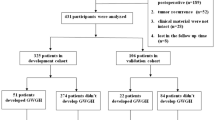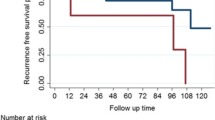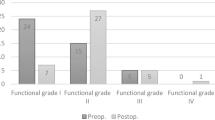Abstract
Background
Craniopharyngioma is a slow-growing tumor classified as benign, but tight adhesion and significant local infiltration to the vital structures are common. In spite of improvement of modern microsurgery techniques and precise anatomical understanding not few cases of this tumor recur, and long-term tumor control and maintenance of quality of life are sometimes difficult. However, very little is known about the effects of the molecular characters of craniopharyngioma on the prognosis.
Methods
Ninety eight cases of craniopharyngioma surgically treated at the Department of Neurosurgery, Tohoku University Hospital and Kohnan Hospital from April 1996 to May 2014, 45 males and 53 females aged from 2 to 80 years (mean, 40.84 years) were retrospectively reviewed, and postoperative outcomes and the possible involvement of the autocrine/paracrine mechanism were investigated. The patients were followed up at intervals of 6 months to assess tumor recurrence, and clinical outcomes were correlated with the findings of immunohistochemical examinations used growth hormone receptor (GHR) and downstream hormones. The follow-up period ranged from 3 to 209 months.
Results
Hormone expression was examined in 88 patients, of which 46 specimens (52.3 %) showed high expression of GHR. The GHR high expression group had a significantly shorter duration of postoperative stable disease compared with the low expression group (logrank test, p = 0.007). Simultaneous high expression of growth hormone (GH) and GHR was found in 33 specimens (37.5 %), and the high expression group had a significantly shorter duration of postoperative stable disease compared with the low expression group (logrank test, p = 0.011). No other hormones showed statistically significant differences in outcomes.
Conclusions
High expression of GHR is associated with shorter duration of postoperative stable disease in patients with craniopharyngioma. If the surgical specimens were craniopharyngiomas with high GHR expression, GH supplementation would be introduced quite prudently.





Similar content being viewed by others
References
Agozzino L, Ferraraccio F, Accardo M, Esposito S, Agozzino M, Cuccurullo L (2006) Morphological and ultrastructural findings of prognostic impact in craniopharyngiomas. Ultrastruct Pathol 30:143–150
Bonsnjak R, Benedicic M, Vittori A (2013) Early outcome in endoscopic extended endonasal approach for removal of supradiaphragmatic craniopharyngiomas: a case series and a comprehensive review. Radiol Oncol 47:266–279
Boongrid A, Laothamatas J, Larbcharoensub N, Phudhichareonrat S (2009) Malignant craniopharyngioma; case report and review of the literature. Neuropathology 29:591–596
Cavallo LM, Prevedello DM, Solari D, Gardner PA, Esposito F, Snyderman CH, Carrau RL, Kassam AB, Cappabianca P (2009) Extended endoscopic endonasal transsphenoidal approach for residual or recurrent craniopharyngiomas. J Neurosurg 111:578–589
Cavallo LM, Solari D, Esposito F, Cappabianca P (2013) The endoscopic endonasal approach for the management of craniopharyngiomas involving the third ventricle. Neurosurg Rev 36:27–38
Chai CY, Chen WT, Hung WC, Kang WY, Huang YC, Su YC, Yang CH (2008) Hypoxia-inducible factor-1 alpha expression correlates with focal macrophage infiltration, angiogenesis and unfavorable prognosis in urothelial carcinoma. J Clin Pathol 61:658–664
Chung TT, Drake WM, Evanson J, Walker D, Plowman PN, Chew SL, Grossman AB, Besser GM, Monson JP (2005) Tumour surveillance imaging in patients with extrapituitary tumours receiving growth hormone replacement. Clin Endocrinol (Oxf) 63:274–279
Couldwell WT, Weiss MH, Rabb C, Liu JK, Apfelbaum RI, Fukushima T (2004) Variations on the standard transsphenoidal approach to the sellar region, with emphasis on the extended approaches and parasellar approaches: surgical experience in 105 cases. Neurosurgery 55:539–550
de Divitiis E, Cappabianka P, Cavallo LM, Esposito F, de Divitiis O, Messina A (2007) Extended endoscopic transsphenoidal approach for extrasellar craniopharyngiomas. Neurosurgery 61:219–228
Duo D, Gasverde S, Benech F, Zenga F, Giordana MT (2003) MIB-1 immunoreactivity in craniopharyngiomas: a clinico-pathological analysis. Clin Neuropathol 57:115–121
Fahlbusch R, Honegger J, Paulus W, Huk W, Buchfelder M (1999) Surgical treatment of craniopharyngiomas: experience with 168 patients. J Neurosurg 90:237–250
Fukunaga S, Maeda K, Noda E, Inoue T, Wada K, Hirakawa K (2006) Association between expression of vascular endothelial growth factor C, chemokine receptor CXCR4 and lymph node metastasis in colorectal cancer. Oncology 71:204–211
Hofmann BM, Hoelsken A, Fahlbusch R, Blumcke I, Buslei R (2010) Hormone receptor expression in craniopharyngiomas: a clinicopathological correlation. Neurosurgery 67:617–625
Hoffman HJ (1994) Surgical management of craniopharyngioma. Pediatr Neurosurg 21(1 Suppl):44–49
Jacobsen J, Grankvist K, Rasmuson T, Bergh A, Landberg G, Ljungberg B (2004) Expression of vascular endothelial growth factor protein in human renal cell carcinoma. BJU Int 93:297–302
Karavitaki N, Cudlip S, Adams CBT, Wass JA (2006) Craniopharyngiomas. Endocr Rev 27:371–397
Karavitaki N, Warner JT, Marland A, Shine B, Ryan F, Aenold J, Turner HE, Wass AH (2006) GH replacement does not increase the risk of recurrence in patients with craniopharyngioma. Clin Endocrinol (Oxf) 64:556–560
Li Q, You C, Liu L, Rao Z, Sima X, Zhou L, Xu J (2013) Craniopharyngioma cell growth is promoted by growth hormone (GH) and is inhibited by tamoxifen: involvement of growth hormone receptor (GHR) and IGF-1 receptor (IGF-1R). J Clin Neurosci 20:153–157
Losa M, Vimercati A, Acerno S, Barzaghi RL, Mortini P, Mangili F, Terreni MR, Santambrogio G, Giovanelli M (2004) Correlation between clinical characteristics and proliferative activity in patients with craniopharyngioma. J Neurol Neurosurg Psychiatry 75:889–892
Mortini P, Losa M, Pozzobon G, Barzaghi R, Riva M, Acerno S, Angius D, Weber G, Chiumello G, Giovanelli M (2011) Neurosurgical treatment of craniopharyngioma in adults and children: early and long-term results in a large case series. J Neurosurg 114:1350–1359
Muller HJ, Gebhardt U, Schroder S, Pohl F, Kortmann RD, Faldum A, Zwiener I, Warmuth-Mets M, Pietsch T, Calaminus G, Kolb R, Wiegand C, Sorensen N (2008) Analyses of treatment variables for patients with childhood craniopharyngioma—results of the multicenter prospective trial Kraniopharyngiom 2000 after three years of follow-up. Horm Res Pediatr 73:175–180
Ogawa Y, Kawaguchi T, Tominaga T (2014) Outcomes and mid-term prognosis after maximum and radical removal of craniopharyngiomas with the priority to the extended transsphenoidal approach—a single center experience. Clin Neurol Neurosurg 125:41–46
Ogawa Y, Watanabe M, Tominaga T (2014) Spontaneous alteration from Rathke’s cleft cyst to craniopharyngioma—possible involvement of transformation between these pathologies. Endocr Pathol 25:422–426
Olsson DS, Buchfelder M, Wiendieck K, Kremenevskaja N, Bengtsson BA, Jakobsson KE, Jarfelt M, Johannsson G, Nilsson AG (2012) Tumour recurrence and enlargement in patients with craniopharyngioma with and without GH replacement therapy during more than 10 years of follow-up. Eur J Endocrinol 166:1061–1068
Prieto R, Pascual JM, Subhin-Issa I, Jorquera M, Ysu M, Martinez R (2013) Predictive factors for craniopharyngioma recurrence: a systemic review and illustrative case report of a rapid recurrence. World Neurosurg 79:733–749
Puget S, Garnett M, Wray A, Grill J, Habrand JL, Bodaert N, Zerah M, Bezerra M, Renier D, Pierre-Kahn A, Sainte-Rose C (2007) Pediatric craniopharyngiomas: classification and treatment according to the degree of hypothalamic involvement. J Neurosurg 106(1 Suppl):3–12
Shen L, Sun CM, Li XT, Liu CJ, Zhou YX (2015) Growth hormone therapy and risk of recurrence/progression in intracranial tumors: a meta-analysis. Neurol Sci 6 (Epub ahead of print)
Disclosure
All authors certify that they have no affiliations with or involvement in any organization or entity with any financial interest (such as honoraria; educational grants; participation in speakers’ bureaus; membership, employment, consultancies, stock ownership, or other equity interest; and expert testimony or patent-licensing arrangements), or non-financial interest (such as personal or professional relationships, affiliations, knowledge or beliefs) in the subject matter or materials discussed in this manuscript.
Financial and material support and previous presentation
None.
Conflict of interest
The authors declare that they have no competing interests.
Author information
Authors and Affiliations
Corresponding author
Rights and permissions
About this article
Cite this article
Ogawa, Y., Watanabe, M. & Tominaga, T. Prognostic factors of craniopharyngioma with special reference to autocrine/paracrine signaling: underestimated implication of growth hormone receptor. Acta Neurochir 157, 1731–1740 (2015). https://doi.org/10.1007/s00701-015-2519-0
Received:
Accepted:
Published:
Issue Date:
DOI: https://doi.org/10.1007/s00701-015-2519-0




